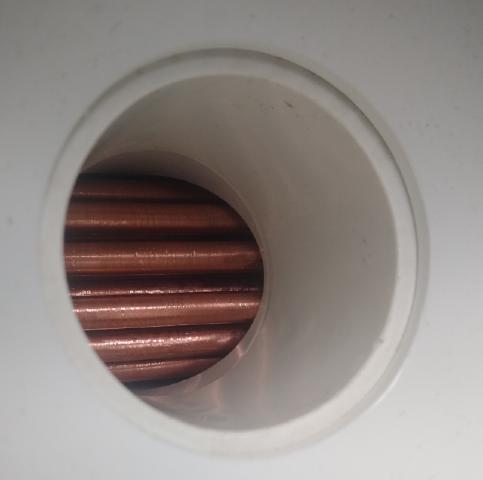|
|
|
|
 |
Author |
|
| Message |  |
|
dpack
Joined: 02 Jul 2005
Posts: 46313
Location: yes
|
|
|
|
 |
Tom Booth
Joined: 06 Jan 2025
Posts: 18
|
 Posted: Mon Feb 10, 25 5:00 pm Post subject: Posted: Mon Feb 10, 25 5:00 pm Post subject: |
 
|
There is a rather long list of Stirling engines based CHP manufacturers/suppliers maintained here:
https://www.stirlingengine.com/recommended/combined/
This list has changed over the years, with additions and subtractions as companies come and go or as startups, fail to actually materialize a product.
The stirlingengine.com domain, BTW is up for sale so may not be available much longer.
Unfortunately, I have been in the market for some such Stirling residential CHP units for the past 20 years or so and have followed the development of these companies with great anticipation, but the fact is, or seems to be, no actual residential units are actually available for sale.
Taking one of the supplied links at random, I quickly encounter this comment left on the site:

And the response:

Due to failure to get beyond the startup/development stage, "restructuring", buyouts, etc. etc. actually obtaining a unit for installation is either out of the question entirely or prohibitively expensive.
If anyone with the time and wherewithall to go through this list again, as I have done many times before over the years and finds that there really is actually something available to homeowners rather than exclusively to oil and gas companies to remotely operate valves on their pipelines or some such thing (Qnergy) I'd love to hear about it.
I haven't been through the list lately, I keep giving up as it is frustrating, irritating, aggravating and seems hopeless. Like looking for the pot of gold at the end of a rainbow, the goal, or prize, as you approach it moves further away into the future.... "...May be available in five years...." or some such.
Maybe the situation has changed since the last time I did any in depth research on availability of such units but I tend to doubt it.
Many of my friends on the Stirling engine forum have also been following the various companies and offerings as they pop up around the world with anxious anticipation, inevitably ending in disappointment and frustration.
There is (or was) probably a thread/discussion, somewhere on the forum covering each of the listed companies. Sometimes a representative of the company would appear on the forum.
You will not, however, find any reviews or reports describing an actual purchase or installation because for one reason or another that never seems to happen.
https://youtu.be/OadiysJS3f0?si=sxMy3K03gJA_0j2Q
I've called Qnergy a few times about the possibility of obtaining one of their remote power systems, but when they hear that my intended end use is domestic power generation for my home/farm they stop returning my calls.
DIY - building your own, seems the only remaining potentially viable option afaik. |
|
|
|
 |
Tom Booth
Joined: 06 Jan 2025
Posts: 18
|
 Posted: Tue Feb 11, 25 4:24 pm Post subject: Posted: Tue Feb 11, 25 4:24 pm Post subject: |
 
|
I do currently have this experimental Stirling engine on the workbench, (actually my living room table at the moment, my workshop is unheated due to living on SS and not having the income anymore for two heating bills).

It is based on, or at least incorporates a lot of the theoretical design/thermodynamic considerations that we have been debating about and experimenting with for the past few years.
In a way,the forum going away has been a blessing in that the endless debate and argument about theoretical considerations has ended (for now, until they find me here I suppose) and I have more time to spend experimenting.
This engine is, aside from being as yet, incomplete and a work in progress, a departure from "established" heat engine theory.
It is intended to run on a relatively modest heat source (unpressurized steam or hot water)
Therefore it can be mostly made from plastic (PVC pipe).
The theme, partly out of my own necessity and lack of resources and available funding is: inexpensive and easy to build. Not requiring precision machining, etc
Though, PVC fittings, I have found, are not all that cheap lately, like pretty much everything else.
The theoretical departure also has to do with the plastic structure.
Heat (as steam) rises from the metal boiler (an empty 1 qt paint can) up the vertical PVC pipe to an internal copper heat exchanger:

From there, the heat is taken in by the air (working fluid) inside the copper pipes and then the heat goes...
Well, the heat, theoretically at least, it "trapped" inside the engine with nowhere to go. The surrounding PVC pipe is largely non-heat conductive (insulating).
There is no provision for any "heat sink" or traditional thermodynamics "cold reservoir" for the removal of the unused "waste heat", on the theory that the engine will be sufficiently efficient that the majority of the modest heat input will be converted to "work" (power output), the heat or energy going in in the form of heat and coming out in the form of mechanical work or torque/horsepower.
Experimentally, this approach of doing away with the cold side of the engine, which I now view as simply a "fuel leak" rather than any kind of assist to engine efficiency or power output, has proven, IMO, viable.
Few, if any, seem to share that opinion and assume heat must still be escaping somewhere.
Of course, some heat is inevitably going to "leak out" through the PVC, regardless, at a relatively slow rate, though, I think, as compared with a dedicated copper water filled cooling jacket designed to dump the scientifically/mathematically calculated 80% or so "waste heat" which "established physics" insists MUST be quickly removed for the engine to complete even one revolution.
Personally, I think conventional thermodynamics theory is complete hogwash. Concocted misinformation promulgated by the oil companies that have a virtual stranglehold on our universities of higher education. In that way they are able to suppress competition by claiming it is fraudulent, a "violation of the second law", use government agencies like the securities and exchange commission to go after them and shut them down, turn away potential investors or other funding etc. etc.
Here is a video of one of my experiments.
The plastic engine was supposed to be solar. Sunlight going in through the clear acrylic top. The metal bottom intended for letting out the excess "waste heat".
I thought this design would be suitable for testing my theoriy
I would reverse the flow, put heat in through the metal bottom where it would then get trapped inside the acrylic engine
For good measure, I also insulated the engine with a silica aerogel blanket to retain as much heat as possible.
Theoretically (according to "established science", the engine could not possibly operate with such a heat bottleneck where the heat only goes in but has no cold "heat sink" for it to get back out. The engine should not be able to run or even start. Certainly it should not be able to complete more than a few revolutions before overheating.
Instead, I found that this engine ran much better, with much less heat input, started up easier and ran much more vigorously than it did previously given the same heat source of steam from a hot cup of water.
https://youtu.be/i9nz0vt7eQA?si=RZKqJMCM5x_RDeSi |
|
|
|
 |
Tom Booth
Joined: 06 Jan 2025
Posts: 18
|
 Posted: Tue Feb 11, 25 5:51 pm Post subject: Posted: Tue Feb 11, 25 5:51 pm Post subject: |
 
|
Aside from the result that in the above experiment the engine ran at all, and at that, faster than usual, another observation was that the displacer, (the black foam disk inside the engine) usually lifted to the top of the chamber to let in heat, in normal engines of this type, due to the rapidity of movement, the magnet, on the bottom of the upper small power piston, did not have enough time to do more than slightly lift the displacer up off the bottom of the chamber, just barely.
So, the heat input, logically, was mush less than usual for this type engine, and yet it was running much better and faster and with more vigor than it ordinarily would.
This experimental results was consistent for quite a wide variety of different model Stirling engines.
My NASA engine was designed to take in approximately 10,000 watts of solar energy heat input, convert a maximum of 3000 watts to electricity and dump the remaining minimum of 8000 watts of "waste heat" into the water jacket to be dissipated.
If we apply the experimental findings to the NASA engine, it should be possible to reduce the heat input and increase performance and power output by a simple redesign of the engine that included doing away with the cooling apparatus that is intentionally, by design, diverting some 80% of the heat input to do nothing but make hot water, and for no particularly good reason, other than in 1820 a Natural Philosopher supposed that heat was some kind of fluid and that a heat engine was like a water wheel that the heat flowed through or over to be let down from a high to a low temperature.
A completely naive conception (IMO) that persists as a fundamental element of accepted heat engine theory down to the present.
In other words, there is room for vast improvement as far as reduction in size and increase in power output, if we can just put "accepted theory" in the trash bin where it belongs and get on with designing engines based on the sound principle of heat as a form of energy that can be converted to other forms of energy rather than some mysterious flowing indestructible all penetrating fluid that has to be let in and then let back out. |
|
|
|
 |
|
Archive
Powered by php-BB © 2001, 2005 php-BB Group
Style by marsjupiter.com, released under GNU (GNU/GPL) license.
|
